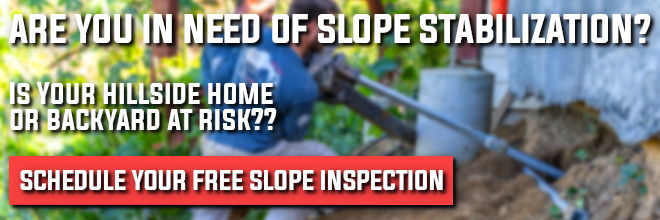There are some forces of nature we just can’t escape – gravity, aging, weight gain (okay, maybe not that last one). Erosion is an inescapable act of mother nature that slowly, but surely, grinds hills down.
What is Erosion?Erosion is the gradual and perpetual geological process of diminution/movement of soil, rock, and sedimentary debris from natural forces such as wind, water, ice, and time. |
Hillside homes have long epitomized wealth and exclusivity – I mean, this is where we get the term a million-dollar-view and why all of the boujee areas of America have hills in the title.
Despite their vistas overlooking luscious vineyards, shimmering expanses of water, or blinking city lights – they are not immune to erosion and have their own unique set of challenges (such as slope stabilization).
In this article, we are going to address challenges unique to Hillside homes:
- Erosion
- Broken Retaining Walls
- Cripple Walls
A significant chunk of our articles covers foundation settlement and foundation heave, both of which are caused by expansive soil.
While hillside homes can experience these phenomena, this article is focused on hillside specific issues
Read more: Can Hills/Slopes Move? And Why?
Erosion
Erosion is public enemy numero uno when it comes to homes built on hillsides. It’s true, what goes up must come down. And, it is also true, what is already up is on its way down (no matter how slowly).
Erosion claws its way into hillsides and mountains with wind, rain, ice – a type of geological sandpaper exerted by the hands of time.
Rain is the biggest instigator of erosion as it bites into the soil and carries dirt, rock, and various debris with it downhill. Vegetation locks roots into the soil and helps keep soil in place during heavy rains.
If there is little to no vegetation, large swaths of a hillside can be washed out and instigate mudslides. Homes built on hillsides with little to no vegetation are at greater risk of erosion.
However, the biggest factor of homes built into/on hills is nonexistent or poor drainage systems.
Fun Facts with Brian – Many geologists consider water to be the strongest element. It can even wear away rock if given enough time. The Colorado River, for example, carved out the Grand Canyon.
Poor/Nonexistent Drainage
Water is incredibly powerful. You might be thinking, but I live in Arizona or Southern California where it doesn’t rain a whole heckuva lot. This could, in fact, put you at greater risk for erosion when it does rain.
You probably have less vegetation than your neighboring wet states and have a poor or nonexistent drainage system.
You have nothing keeping your soil in place, soaking up extra water and you have nothing rerouting water away from your home.
Many homes in Southern California and Arizona don’t have proper drainage systems, let alone the bare necessities to weather a deluge. This can put your primary financial investment in jeopardy.
Weathering is the breakdown of sedimentary elements. Erosion is the movement, relocation of the broken-down elements.
Fun Facts with Brian: The hydrosphere (water) significantly affects the geosphere (earth) through mechanical (roots of plants, heat from the sun, running water, frost, etc.) and chemical weathering (carbon dioxide, oxygen, & acids causing shape change/breakdown).
Many homes in Southern California built on slopes have been red-tagged and closed down by the city because they were deemed unsafe.
Here at Dalinghaus, we highly recommend at least implementing the following:
- Rain Gutters
- Downspouts directed away from the house
- Concrete poured/angled at a 2-degree slope away from the house
- Properly grated/drained concrete and soil
Just like with foundation settlement and foundation heave, there are signs and symptoms to look for when it comes to poor drainage.
Signs you need a better drainage system:
- Soil erosion
- Sodden/ Spongy yard
- Cracked foundation/washed out footing
- Puddles that refuse to evaporate or take a long time doing so
- Flooding on your property
- Water pooling on your walkways, patios, or driveways
- Soil/Silt washes onto your sidewalks during a rainstorm
If your property has any of the symptoms above, regardless if you live on a slope or not, you will want to hire a drainage specialist to install a drainage system.
The two primary types of drainage systems are:
Surface Water Drainage Systems
Surface water drainage systems externally channel water away from softscape (i.e. flowerbeds/lawns) and hardscape (i.e. concrete patios/driveways) areas where excess moisture inherently collects/pools. Surface water drainage systems typically conduct runoff to storm drains, creeks, or underground drainage systems.
Underground Ground Drainage Systems
Underground drains, such as French Drains, channel water away from overly saturated soil, lawns, and vegetated areas, directing the water to storm drains or creeks or simply away from a home. Underground drains are incredibly effective at preventing erosion.
Fun Facts with Brian –In the first century Biblical Parable of the House on the Rock, Jesus described how it was imperative to have a solid foundation that could combat erosion.
“The rain came down, the floods came, and the winds blew, and beat the house; and it didn’t fall, for it was founded on the rock.”
In short, with the proper drainage, you can slow down erosion but never stop it completely.
We live on a beautiful planet that is in perpetual motion, an ever-changing and evolving geological landscape.
Broken Retaining Walls
Retaining walls are a favorite type of slope stabilization. The retaining wall acts as a barrier and retains the weight of the load behind it. This ties back into rain.
Wet soil is heavy soil. And heavy soil on a slip plane is bound to follow gravity.
When one section of soil is relocated, the section of soil above it moves in to fill in the gap, causing a chain reaction.
Broken retaining walls can actually lead to a slippery slope – if some soil slips, more will move, and so on.
This is why it’s imperative to ensure your retaining walls have weepholes and proper drainage.
Retaining walls without proper drainage or support can bow outward and break, unable to sustain the load exerted on it.
Retaining walls are a major line of defense against erosion and help keep hillside homes in place. It is imperative to repair failed retaining walls to ensure the security of one’s property and home.
Cripple Walls
Cripple Walls are a bit of an outlier because they are by no means limited to homes built into hillsides.
However, they were a popular option prior to the 1960s for homes that needed one section of the foundation to sit directly on gradient and the other section to sit above gradient to keep the home level.
Cripple Walls are a type of raised foundation. The stud walls sit between the foundation and the home (often ranging between 2 to 4 feet high) and are not often properly secured.
As far as raised foundations go, these are the weakest form. It is a good idea to seismically retrofit your cripple wall foundation to improve stability and security in the event of an earthquake.
You want to keep your hillside home exactly where it is, not go sailing with it downhill.
Dalinghaus Can Help
Here at Dalinghaus, we specialize in foundation repair and slope stabilization. If you believe your retaining wall is failing or need your cripple wall seismically retrofitted, we have your back.
Check out our job story Stabilizing A La Jolla Hillside Home With Push Piers
Remember kids:
- Rain is your home’s number one enemy when it comes to erosion
- Broken retaining walls actually do lead to a slippery slope
- Cripple Walls can cripple your home if not seismically retrofitted
If you live in sunny Southern California or Central Arizona and want a FREE foundation inspection , click the link below –
Or, if you need slope stabilization, click the link below –








